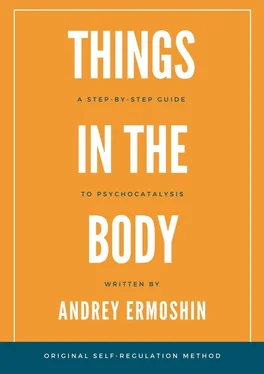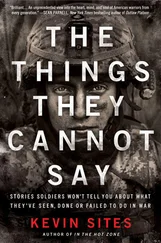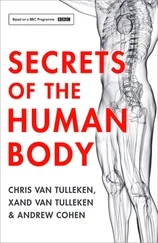I recommend paying attention to the description of this kind of work in the Chapter «The Case». There you can see the typical ’growing’ of person from session to session.
In conclusion, I would like to say that starting the recovery process with a constructive drawing of a human figure can help a lot in a systematic work through the patient’s problems during the psychotherapeutic communication. Using the drawings can help the patients to determine what was in the depths of their consciousness delaying their free development. They help to actualize the hidden experiences that seem to belong to the past, but, nevertheless, remain in the present and continue to have a negative impact on the patient’s life. It is difficult to overestimate the usefulness of drawings as an indicator of the patient’s condition when everything only outwardly looks normal.
In cases where the patient is experiencing significant anxiety and is clearly aware of their trouble, the use of drawings becomes unnecessary, even inappropriate. With all the sympathy for them, we must realize that they are the artificial means of obtaining material for the work.
Both in case of work from a conversation that reveals the actual experience, and in case of work from the drawing, the so-called ’principle of non-slipping’ works. The first mention of a significant experience is a sufficient reason to study it. Listening to the enumeration of the patient’s troubles is a useless exercise. To deal with their consequences is much more productive.
From the dream
The starting point for the work can also be a dream. Here is one example of the work “from a dream’ in more details, as no description of this kind is further expected.
The main idea is that any dream as a whole or its elements are provided with a specific charge or their combination. For every dream there is an equivalent in sensations at the level of the body. So, the question is: «Where is the feeling associated with this dream or the dream element?» For example, the patient’s respond is ’in the head’.
The dream of patient P. was determined by the experience of betrayal, and his feelings associated with it were in his back.
From heads to tails
Patient P. is twenty-eight years old. He is not married and lives with his mother. His father, abusing alcohol, died when he was fourteen. At the age of twenty-four he went through a difficult parting with his girlfriend who was waiting for him from to resign from the Navy. He gave up his Midshipman shoulder straps for her. But after his return from military service she decided to leave him. The patient took her statement about their break-up as a blow which caused much pain.
He tried to forget her. He started dating another girl he had been introduced to. Their relations were warm but without love, and their wedding did not take place. Because of that he was very upset, and everything began «to fall out of his hands’.
Being soft and deep by his character, he used to write poetry and paint in his youth. He was also interested in philosophy. But now he has not got any special interests. He complains about «lack of spirituality’ in his life. He says that he does not want to do anything. «There is no purpose in my life. I am waiting for some fairy godmother or social worker to come and help me rebuild myself. I am still a dime. But I was thrown from the heads to the tails,» P. sums up his sad story. Some time ago because of all that background he began to drink a lot of alcohol with his friends to ’feel better’. Once he was stabbed in the heart. Fortunately, the knife hit his rib. He explains psychological gain from such behavior by ’obtaining new information’. Those ’guys’ were the only real opportunity to share experiences.
The characters in his drawings are not all standard. In response to the proposal to continue drawing after the first one was made, he gave almost abstract compositions from the given standard elements: squares, circles and triangles. The third figure in this series was subsequently decoded (Fig. 1). It turned out that it echoes the dream, which was the starting point for one of the episodes of the work. It depicts a sprawled man. «Two holes in him, in and out.»

Fig. 1
The dream refers to the period of 1995, when he broke up with the second girlfriend and felt as if something was also broken inside him. «I fell down on a piece of rebar at the construction site and it punched me through.» Some of his dreams the patient perceived as prophetic, so he stopped diving from a high of 8—10 meters, as he used to do.
His dream was rather old, but since the patient mentioned it today, I suggested to ’check’ where he was at that moment: still on the rebar or had already got off it.
«I’ve got off.»
«Was the wound healed?»
«How many percent?» I often use this question in my work. Its undoubted advantage is that it is completely «safe’. In case, «the wound’ is a hundred percent healed, it makes sense, if not a hundred percent – it makes sense as well.
Clarifying the feeling, the patient found out that his wound was not actually healed yet.
«Is there something about her that won’t let it heal?»
«Yes.»
«What is it?»
«Rust.»
«Much or little?»
«Much.»
«What will you do with it?»
«I will throw it away.»
«Proceed!»
While cleaning his wound from the rust, P. noticed that inside it was full of pus, and outside it was covered with a crust.
«What is the diameter of the crust?»
With his hands he showed a circle of a small plate. There was a crust on his back, below the shoulder blades.
«Do you need it for something?»
«No. It keeps the pus from coming out. If I squeeze it from inside, it comes out only in drops.»
«What will you do with it?»
«Pry it off»
He did it.
«Where will you put the pus: in a bucket, in a hole, in a toilet bowl, or somewhere else?
«The pus is running down my back.»
«Has the wound started to heal?»
«Yes. But there are still white streaks of pus».
«How many percent is it healed?
«65.»
«Shall it go on healing?»
«I apply some healing ointment, a bandage, and cover myself with a warm blanket. I need some rest.»
By the end of our conversation, I asked again about the condition of his wound.
«It’s almost healed,» was his answer.
As a rule, back injuries appear because of betrayal («a knife in the back’). In the case of P., it was a piece of rebar . There are also can be other causes of problems in this zone – functional blocks in the vertebral-motor segments (displacement of the vertebrae). Below we will talk about the non-psychic factors involved in the formation of sensations.
From the story about the events
“Now that you have spoken so beautifully about the events that have occurred in your life, I would like you to continue and describe the feelings that you experience as a result.” It seems significant to me. The patients are invited to make a more complete description of their condition.
From the images
If a jealous woman is “driven crazy’ by imaginary scenes of her husband’s cheating (“I go crazy when I imagine her hands on his neck…") – one can ask what she feels when she sees these scenes. Where is the charge associated with her emotion: in the head, in the chest, in the stomach? Is it big or small? etc. There appear a “black funnel’ in the abdomen. The direct correlation between the brightness, proximity of images of significant persons and the size of internal formations existing in relation to them is obvious.
Читать дальше













